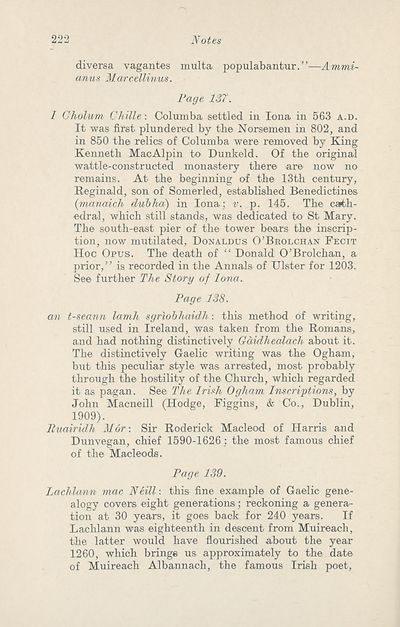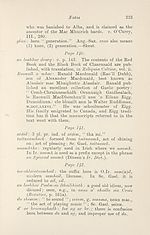Download files
Complete book:
Individual page:
Thumbnail gallery: Grid view | List view

222
Notes
diversa vagantes multa populabantur.”—Ammi~
anus Marcellinus.
Page 187.
1 Gholum Chille: Columba settled in Iona in 563 a.d.
It was first plundered by the Norsemen in 802, and
in 850 the relics of Columba were removed by King
Kenneth MacAlpin to Dunkeld. Of the original
wattle-constructed monastery there are now no
remains. At the beginning of the 13th century,
Reginald, son of Somerled, established Benedictines
(manaich dubha) in Iona; v. p. 145. The cath¬
edral, which still stands, was dedicated to St Mary.
The south-east pier of the tower bears the inscrip¬
tion, now mutilated, Donaldus O’Brolchan Fecit
Hoc Opus. The death of “ Donald O’Brolchan, a
prior,” is recorded in the Annals of Ulster for 1203.
See further The Story of Iona.
Page 138.
an t-seann lamh sgriobhaidh: this method of writing,
still used in Ireland, was taken from the Romans,
and had nothing distinctively Gaidhealach about it.
The distinctively Gaelic writing was the Ogham,
but this peculiar style was arrested, most probably
through the hostility of the Church, which regarded
it as pagan. See The Irish Ogham Inscriptions, by
John Macneill (Hodge, Figgins, & Co., Dublin,
1909).
Ruairidh M6r: Sir Roderick Macleod of Harris and
Dunvegan, chief 1590-1626; the most famous chief
of the Macleods.
Page 139.
Lachlann mac Neill: this fine example of Gaelic gene¬
alogy covers eight generations; reckoning a genera¬
tion at 30 years, it goes back for 240 years. If
Lachlann was eighteenth in descent from Muireach,
the latter would have flourished about the year
1260, which brings us approximately to the date
of Muireach Albannach, the famous Irish poet,
Notes
diversa vagantes multa populabantur.”—Ammi~
anus Marcellinus.
Page 187.
1 Gholum Chille: Columba settled in Iona in 563 a.d.
It was first plundered by the Norsemen in 802, and
in 850 the relics of Columba were removed by King
Kenneth MacAlpin to Dunkeld. Of the original
wattle-constructed monastery there are now no
remains. At the beginning of the 13th century,
Reginald, son of Somerled, established Benedictines
(manaich dubha) in Iona; v. p. 145. The cath¬
edral, which still stands, was dedicated to St Mary.
The south-east pier of the tower bears the inscrip¬
tion, now mutilated, Donaldus O’Brolchan Fecit
Hoc Opus. The death of “ Donald O’Brolchan, a
prior,” is recorded in the Annals of Ulster for 1203.
See further The Story of Iona.
Page 138.
an t-seann lamh sgriobhaidh: this method of writing,
still used in Ireland, was taken from the Romans,
and had nothing distinctively Gaidhealach about it.
The distinctively Gaelic writing was the Ogham,
but this peculiar style was arrested, most probably
through the hostility of the Church, which regarded
it as pagan. See The Irish Ogham Inscriptions, by
John Macneill (Hodge, Figgins, & Co., Dublin,
1909).
Ruairidh M6r: Sir Roderick Macleod of Harris and
Dunvegan, chief 1590-1626; the most famous chief
of the Macleods.
Page 139.
Lachlann mac Neill: this fine example of Gaelic gene¬
alogy covers eight generations; reckoning a genera¬
tion at 30 years, it goes back for 240 years. If
Lachlann was eighteenth in descent from Muireach,
the latter would have flourished about the year
1260, which brings us approximately to the date
of Muireach Albannach, the famous Irish poet,
Set display mode to:
![]() Universal Viewer |
Universal Viewer | ![]() Mirador |
Large image | Transcription
Mirador |
Large image | Transcription
| An Comunn Gàidhealach > An Comunn Gàidhealach Publications > Rosg Gaidhlig > (238) |
|---|
| Permanent URL | https://digital.nls.uk/126280244 |
|---|
| Description | This contains items published by An Comunn, which are not specifically Mòd-related. It includes journals, annual reports and corporate documents, policy statements, educational resources and published plays and literature. It is arranged alphabetically by title. |
|---|
| Description | A collection of over 400 items published by An Comunn Gàidhealach, the organisation which promotes Gaelic language and culture and organises the Royal National Mòd. Dating from 1891 up to the present day, the collection includes journals and newspapers, annual reports, educational materials, national Mòd programmes, published Mòd literature and music. |
|---|---|
| Additional NLS resources: |
|

